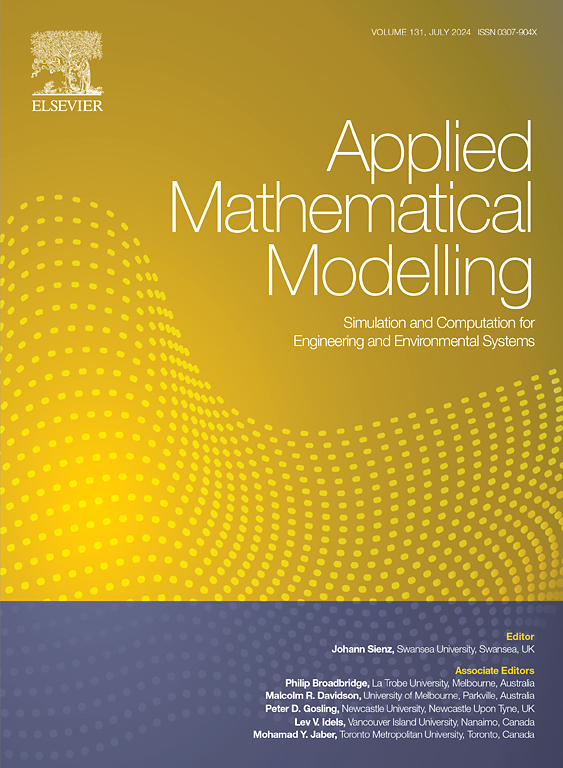移动谐波载荷下改良季莫申科薄壁梁的弯曲扭转振动响应
IF 4.4
2区 工程技术
Q1 ENGINEERING, MULTIDISCIPLINARY
引用次数: 0
摘要
本文提出了一种新方法,用于计算移动谐波载荷作用下改良季莫申科薄壁梁的弯曲扭转振动响应。梁的边界条件被认为是两端简单支撑。通过使用傅里叶和拉普拉斯变换,得出了振动响应的解析解。为了验证所提出的方法,将所提出的方法得出的结果与有限元法(FEM)得出的结果进行了比较。通过参数分析,进一步研究了横截面特性以及载荷大小、速度和偏心率的影响。结果表明(1) 与忽略剪切旋转惯性的方法相比,用提出的方法计算的梁中跨垂直位移精度提高了 6.87%;(2) 弯曲扭转振动频率随扭转惯性矩的增加而增加;(3) 当速度从 20 m/s 增加到 80 m/s 时,中跨处最大位移的差异基本在 5%以内;(4) 弯曲扭转振动响应受荷载大小和偏心率的影响很大,而梁的振动频率不受这些变化的影响;(5) 荷载速度的增加并不总是导致梁的响应增大,这可以从共振的角度来解释。本文章由计算机程序翻译,如有差异,请以英文原文为准。
Bending-torsional vibration response of modified Timoshenko thin-walled beams under moving harmonic loads
In this paper, a new method is proposed for calculating the bending-torsional vibration response of modified Timoshenko thin-walled beams under moving harmonic loads. The boundary conditions of the beams are considered to be simply supported at both ends. By using Fourier and Laplace transformations, analytical solutions for vibration responses are derived. For the validation of the proposed method, the results obtained using the proposed method are compared with those acquired by the finite element method (FEM). Through the parametric analysis, the effects of cross-sectional properties as well as the load magnitude, velocity, and eccentricity are further investigated. The results indicate that: (1) compared to the method that ignores shear rotary inertia, the vertical displacement of the beam at the midspan calculated by the proposed method shows an accuracy improvement of up to 6.87%; (2) the bending-torsional vibration frequency increases with the growth of the torsional moment of inertia; (3) when the velocity increases from 20 m/s to 80 m/s, the difference in the maximum displacement at the midspan is essentially within 5%; (4) the bending-torsional vibration response is significantly influenced by the load magnitude and eccentricity, whereas the vibration frequency of the beam remains unaffected by these variations; (5) an increase in load velocity does not always lead to a greater response from the beam, which can be explained from the perspective of resonance.
求助全文
通过发布文献求助,成功后即可免费获取论文全文。
去求助
来源期刊

Applied Mathematical Modelling
数学-工程:综合
CiteScore
9.80
自引率
8.00%
发文量
508
审稿时长
43 days
期刊介绍:
Applied Mathematical Modelling focuses on research related to the mathematical modelling of engineering and environmental processes, manufacturing, and industrial systems. A significant emerging area of research activity involves multiphysics processes, and contributions in this area are particularly encouraged.
This influential publication covers a wide spectrum of subjects including heat transfer, fluid mechanics, CFD, and transport phenomena; solid mechanics and mechanics of metals; electromagnets and MHD; reliability modelling and system optimization; finite volume, finite element, and boundary element procedures; modelling of inventory, industrial, manufacturing and logistics systems for viable decision making; civil engineering systems and structures; mineral and energy resources; relevant software engineering issues associated with CAD and CAE; and materials and metallurgical engineering.
Applied Mathematical Modelling is primarily interested in papers developing increased insights into real-world problems through novel mathematical modelling, novel applications or a combination of these. Papers employing existing numerical techniques must demonstrate sufficient novelty in the solution of practical problems. Papers on fuzzy logic in decision-making or purely financial mathematics are normally not considered. Research on fractional differential equations, bifurcation, and numerical methods needs to include practical examples. Population dynamics must solve realistic scenarios. Papers in the area of logistics and business modelling should demonstrate meaningful managerial insight. Submissions with no real-world application will not be considered.
 求助内容:
求助内容: 应助结果提醒方式:
应助结果提醒方式:


